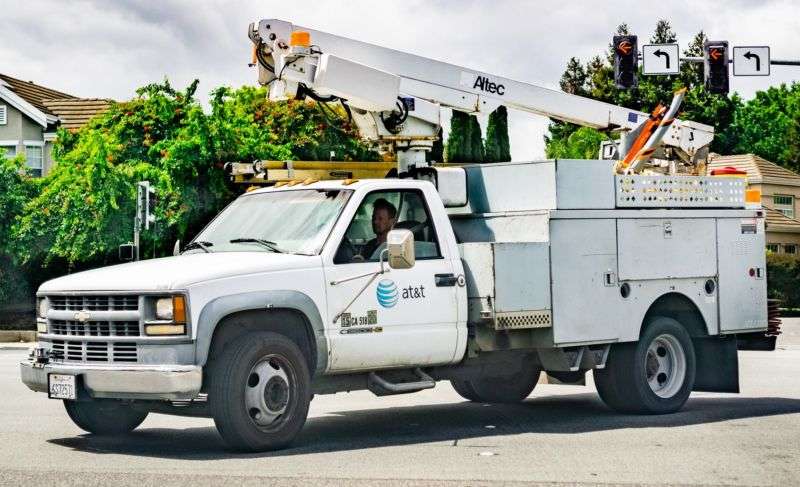
AT&T cuts another 1,800 jobs as it finishes fiber-Internet buildout

AT&T has informed employees of plans to cut another 1,800 jobs from its wireline division, an AT&T workers’ union told Ars today.
Last week, AT&T declared more than 1,800 jobs nationwide as “surplus,” meaning they are slated to be eliminated in August or September, the Communications Workers of America (CWA) told Ars.
“They’ve been cutting their employment massively in the past year and a half or so,” with cuts affecting both union and non-union jobs, CWA Communications Director Beth Allen told Ars. Under union contracts, AT&T can declare a surplus of jobs each quarter, she said. But even by AT&T standards, last week’s surplus declaration “was a very large number,” Allen said.
Jobs that are declared “surplus” are taken off the payroll, CWA says.
AT&T told Ars that most affected union workers will be able to stay at the company in other positions. An AT&T spokesperson said:
It would be misleading to refer to this as “layoffs.” Most affected CWA-represented employees, including affected employees in the Midwest and Southwest, have a job-offer guarantee that ensures they’ll be offered another job with the company—only those who volunteer to leave or decline a job offer will leave the company. In the Southeast, affected employees can choose to participate in our Job Bank Program for up to a year, during which time they receive a severance payment; continue to receive benefits and accrue credit for their pension; and can receive priority consideration and relocation benefits (if applicable) for other job opportunities as a regular employee.
But letters from AT&T to the CWA say that only 27 of about 550 employees declared “surplus” in the Southwest division will be given so-called “follow-the-work” opportunities in which they can take nearly identical jobs in other locations.
Follow-the-work offers are given when an employee’s specific job is consolidated with another position or moved to another geographic location, AT&T said. This is different from the job-offer guarantee that ensures “surplus” employees will be offered a different type of job in the company; AT&T didn’t say exactly how many surplus employees will get those offers.
“AT&T is eliminating a person’s job and forcing them to make a choice—take another job, sometimes far away from home, sometimes at a lower rate of pay, or leave the company,” Allen said. “I think that most people would call that a layoff, but whatever way you look at it, it’s a job cut. We have negotiated protections for our members, including the Job Bank in the Southeast, that help cushion the blow when jobs are eliminated.”
Wireline techs bear the brunt
The 1,800 newly announced AT&T job cuts affect wireline technicians who fix customer problems, install new service, and who work on AT&T’s fiber expansion, Allen said. Over the past four years, AT&T expanded its fiber-to-the-home network to 12.5 million customer locations to meet a government mandate imposed on its purchase of DirecTV.
But AT&T is apparently slowing its fiber deployments now that it has finished the government-mandated buildout. “That’s behind us now,” AT&T Communications CEO John Donovan told FierceTelecom in an interview this month. “We’ll continue to invest in fiber, but we’ll do it based on the incremental, economic case. We’re not running to any household target.”
The union says AT&T could do much more to expand fiber access and fix problems in AT&T’s degrading copper networks.
“We think there is a lot of work to be done on the network, both on repairing the existing network and in building fiber out to a lot more places in the country. Our members are well-trained and happy to do it,” Allen said.
To explain the “surplus” jobs, AT&T told Ars that “nationally, we lost nearly 1.9 million wireline access lines between 2016 and 2018—a decrease of over 32 percent in just two years.”
Of course, many customers who leave AT&T live in areas where the company hasn’t upgraded from copper to fiber and are stuck paying high prices for slow speeds. AT&T investing more in the older parts of its network could help reduce those customer losses.
“We understand the decline in the wireline business,” Allen told Ars. “But there are still lots of places across the country where AT&T could invest in building next-generation networks.”
“Reduction in workload”
Leaked internal documents confirmed most of the 1,800 planned job cuts. One AT&T surplus declaration shows that more than 900 of the surplus jobs come from the company’s Southeast division in Alabama, Florida, Georgia, Kentucky, Louisiana, Mississippi, North Carolina, South Carolina, and Tennessee. This document attributes most of the cuts to “economic” reasons and some to “technological/operational efficiency.”
Separately, the previously mentioned letters from AT&T to CWA District 6 list about 550 job cuts in the Southwest division in Arkansas, Kansas, Missouri, Oklahoma, and Texas. The letters say that job cuts are being made “as a result of a reduction in workload.”
There are also about 330 pending job cuts in AT&T’s Midwest division, Allen told Ars.
The 1,800 surplus jobs are in addition to 368 announced last month in AT&T’s West division, which affected some workers in Nevada and a larger number in California, Allen said.
AT&T offers wireline service in 21 states.
CWA also released four reports last week detailing AT&T wireline network problems in Wisconsin, Ohio, Michigan, and Indiana. CWA argues that AT&T is “abandoning” rural communities in these states by allowing its landline networks to fall into disrepair. CWA has been bargaining with AT&T for new contracts in these states.
“As a result of the 20 percent workforce reduction at AT&T [in Ohio], customers are experiencing poor service due to lack of plant maintenance and long waits for repairs to fix issues,” CWA’s report on AT&T’s network in Ohio said.
AT&T told Ars that it is investigating the specific problems raised in the reports “and will make needed repairs.”
AT&T cuts jobs despite government favors
AT&T in November 2017 pushed for a corporate tax cut by promising to invest an additional $1 billion in 2018, with CEO Randall Stephenson saying that “every billion dollars AT&T invests is 7,000 hard-hat jobs. These are not entry-level jobs. These are 7,000 jobs of people putting fiber in ground, hard-hat jobs that make $70,000 to $80,000 per year.”
The federal tax cut was approved by Congress and President Trump and reportedly gave AT&T an extra $3 billion in cash in 2018. The Federal Communications Commission also deregulated the broadband industry and repealed net neutrality rules, with Chairman Ajit Pai claiming the move would spur new broadband investment.
AT&T is upgrading its nationwide wireless network from 4G to 5G, but even that big project isn’t enough to offset declining investment in AT&T’s copper and fiber home Internet networks. AT&T’s capital expenditures were $5.2 billion in Q1 2019, down from $6.1 billion in Q1 2018.
At the beginning of 2018, AT&T told investors that its full-year capital expenditures would be $23 billion, including the “extra” $1 billion that AT&T claimed it would spend because of the tax cut. In reality, AT&T’s capital expenditures ended up being $21.3 billion in the full year of 2018, down from $21.6 billion in 2017 and $22.4 billion in 2016.
“We have invested more in the US than any other public company over the past five years (2014-2018)—more than $130 billion in our wireless and wireline networks, including capital investments and acquisitions of wireless spectrum and operations,” AT&T told Ars today.
23,000 jobs cut since end of 2017
As we’ve previously reported, AT&T’s financial statements show that it cut more than 23,000 jobs between December 31, 2017, and March 31, 2019. AT&T’s overall workforce grew from 254,000 to 262,290 in that time, but only because the telco added 31,618 people by acquiring Time Warner and other companies. Excluding jobs added via mergers, AT&T’s head count declined by 23,328 even before last week’s and last month’s surplus announcements.
AT&T generally responds to reports of job cuts by pointing out that it is also hiring new employees in other divisions. It did so again today, saying, “We continue to hire in areas where we’re seeing increasing demand for products and services. But technology is changing rapidly, and there are fewer jobs in parts of the industry that are declining and facing technology shifts, like our wireline business where these employees work.”
But as Allen told Ars, “we’ve seen no evidence of adding jobs, and when you look at the overall numbers in their reports, they’re down 23,000 employees from a year and a half ago. If they’re creating these jobs, it’s not clear where they are. They’re not showing up in their numbers.”




